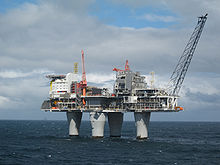Troll A
The Troll A is the largest gas production platform of the North Sea and the largest oil platform in the world. It is used to extract natural gas from the Troll gas field in the Norwegian Exclusive Economic Zone of the North Sea.
Troll gas field
The Troll gas field is about 100 km off the Norwegian coast, west of Bergen . Natural gas was first discovered there in 1979. The gas field is the largest natural gas discovery in the North Sea and is expected to supply natural gas for 50 to 70 years. From here, the natural gas produced will be delivered by pipeline ( Pipeline exported to various countries in Europe). The Troll gas field is operated by the Norwegian oil company Equinor (formerly Statoil ). It was developed under the management of the Shell Group. The planning lasted until 1990, the construction of the oil rig and the development of the gas field took place from 1992 to 1995.
Construction of the oil rig
In 1992, the Norwegian company Aker Kværner began building the Condeep construction rig . In 1993 a 36-meter-high base dome was built in the dry dock of Stavanger , on which the four 343-meter-high concrete columns were built in the Norwegian Vats Fjord from summer 1994 . A special process from the Austrian company Gleitbau was used, which enabled the construction in one go by means of sliding formwork and thus kept the construction time short. The main advantage of this process, however, is that the columns could be cast in one piece. The background to this is that with such highly stressed and critical structures, any connection seam would represent a potential weak point, which is why the use of sliding formwork was particularly important here.
Also on land, the 22,500-tonne working platform was put together from various modules, so that in January 1995 the “rendezvous” could begin from the drilling platform base and the working platform. For this purpose, the ballast tanks in the base as well as the entire columns were flooded and lowered in the fjord so that the four columns only protruded 6.5 meters above the water level. Then the working platform floating on pontoons could be pulled over the columns by tugs .
During a similar maneuver on a sister platform of the Troll A - the Sleipner A - an accident occurred while the columns were flooded. Due to the pressure conditions, the columns imploded and sank to the sea floor. The impact on the sea floor could be registered as a magnitude 3 earthquake.
After assembly, the entire drilling platform was raised so that it towered 230 meters above sea level and could be pulled to its destination in May 1995. Ten tugs with a total of 130,000 horsepower needed ten days to tow the rig at a speed of 1.7 knots to the Troll gas field 170 nautical miles away. With this transport, the platform is considered to be the largest and heaviest structure ever moved by human hands.
After the transport, the Troll A was lowered to the seabed. Within a few days, the rig sank about nine meters into the soft seabed due to its own weight. The working platform is finally about 30 meters above sea level. At its destination, a floating hotel platform was connected to the Troll A via a gangway. This is not anchored, but is held in its exact position by computer-controlled motors.
When the Troll A started its work, 40 drill pipes were driven into the Troll gas field to a depth of 1200 meters. In the late summer of 1995, the laying of the pipelines on the seabed began, so that gas production could already be started in May 1996. The gas pipeline is led through a diagonal tunnel from the 250 meter deep seabed to the processing station on the coast through the Norwegian coastal mountains. The construction work on this tunnel had already started at the beginning of the construction work on Troll A and proved to be extremely difficult.
Troll A's compressors are supplied by a 70 km long HVDC submarine cable from Kollsnes. IGBTs are used as converter valves. The compressor motor with an output of 40 MW is fed with 56 kV directly from the output of the converter.
Technical specifications
- Start of construction: 1992
- Completion: 1995
- Height: 472 m (from the base to the top of the gas flare mast )
- Weight: 656,000 t
- Water depth at the site: 303 m
- Project cost $ 4.75 billion
- Power supply: HVDC Troll
Trivia
The American television broadcaster Discovery Channel has produced a documentary film about the construction, transport and commissioning under the title "Gas giant in the North Sea - The Sea Troll".
Deepest underwater concert
On October 3, 2006, a concert by the British-Georgian singer Katie Melua took place in the base of the platform - 303 meters below the water level . Under great security precautions, she played around 30 minutes in front of an audience of only 40 people. The concert was recorded in the Guinness Book of Records as the deepest concert ever held . In May 2007, the DVD documentary Concert Under The Sea was released , reporting on the preparations and the concert.
Web links
- Information and situation map on the Equinor homepage
- Statoil: The Gas Machine (multimedia presentation of the Troll platform (English, requires Flash))
- Troll A platform on Structurae : International database for bridge construction, civil engineering, tunnel construction and building construction
Coordinates: 60 ° 40 ′ 0 ″ N , 3 ° 40 ′ 0 ″ E

